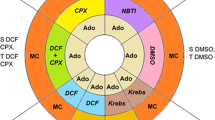Summary
We have investigated the phenylalkylamine binding site in canine cardiac sarcolemmal preparations using (−)-[3H]-desmethoxyverapamil as the labeled ligand. Radioligand binding experiments were carried out in 10 mM Hepes (Na+) buffer and 1 mM EGTA, at pH 7.4 and 20°C. A single high affinity binding site for (−)-[3H]-desmethoxyverapamil was identified both by saturation and competition binding experiments. Several phenylalkylamine derivatives such as (−)-D600, (+)-D600, verapamil and (+)-desmethoxyverapamil completely inhibited (−)-[3H]-desmethoxyverapamil binding with the following order of potency: (−)-desmethoxyverapamil>(−)-D600>verapamil>(+)-desmethoxyverapamil=(+)-D600. In contrast to this, ronipamil, a new long acting phenylalkylamine derivative, produced only a 70% inhibition. Diltiazem also completely inhibited (−)-[3H]-desmethoxyverapamil binding to canine cardiac sarcolemma while nifedipine displaced only 70% of binding. (−)-[3H)-desmethoxyverapamil binding was also inhibited by Ca++ and Mg++. These data suggest the presence of a saturable, reversible and stereoselective phenylalkylamine binding site in canine cardiac sarcolemmal preparations which may be a receptor for the phenylalkylamine Ca++ channel inhibitors.
Similar content being viewed by others
References
Fleckenstein A (1977) Specific pharmacology of calcium in myocardium, cardiac pacemakers and vascular smooth muscle. Ann Rev Pharmacol Toxicol 17:149–166
Galizzi JP, Fosset M, Lazdunski M (1984) [3H]verapamil binding sites in skeletal muscle transverse tubule membranes. Biochem Biophys Res Commun 118:239–245
Galizzi JP, Fosset M, Lazdunski M (1985) Characterization of the Ca2+ coordination site regulating binding of Ca2+ channel inhibitors d-cis-diltiazem, (±)bepridil and (−)desmethoxyverapamil to their receptor site in skeletal muscle transverse tubule membranes. Biochem Biophys Res Commun 132:49–55
Glossmann H, Ferry DR, Goll A, Stricssnig J, Zernig G (1985) Calcium channels and calcium channel drugs: recent biochemical and biophysical findings. Drug Res 35:1917–1935
Goll A, Ferry DR, Stricssnig J, Schober M, Glossmann H (1984) (−)(3H)Desmethoxyverapamil, a novel Ca2+ channel probe. FEBS Lett 176:371–377
Goll A, Glossmann H, Mannhold R (1986) Correlation between the negative inotropic potency and binding parameters of 1.4-dihydropyridine and phenylalkylamine calcium channel blockers in cat heart. Naunyn Schmiedeberg's Arch Pharmacol 334:303–312
Janis RA, Sarmiento JG, Maurer SC, Bolger GT, Triggle DJ (1984) Characteristics of the binding of3H-nitrendipine to rabbit ventricular membranes: modification by other Ca2+ channel antagonists and by the Ca2+ channel agonist BAY K 8644. J Pharmacol Exp Ther 231:8–15
Lee SW, Schwartz A, Adams RJ, Yamon Y, Whitmer K, Lane LK, Wallik ET (1983) Decrease in Na+-K+-ATPase activity and (3H)ouabain binding sites in sarcolemma prepared from hearts of spontaneously hypertensive rats. Hypertension 5:682–688
Lowry OH, Rosebrough NJ, Farr AL, Randall RJ (1951) Protein measurements with the Folin phenol reagent. J Biol Chem 193:265–275
Munson PJ, Rodbard D (1980) Ligand: a versatile computerized approach for characterization of ligand-binding systems. Anal Biochem 107:220–239
Nawrath H, Raschack M (1984) Calcium antagonistic effects of the radioligand (−)-desmethoxyverapamil on cardiac and vascular smooth muscle preparations. Cell Calcium 5:316
Ptasienski J, McMahon KK, Hosey MM (1985) High and low affinity states of the dihydropyridine and phenylalkylamine receptors on the cardiac calcium channel and their interconversion by divalent cations. Biochem Biophys Res Commun 129:910–917
Reynolds IJ, Snowman AM, Snyder SH (1986) (−)-[3H]-desmethoxyverapamil labels multiple calcium channel modulator receptors in brain and skeletal muscle membranes: differentiation by temperature and dihydropyridines. J Pharmacol Exp Ther 237:731–738
Ruth P, Flockerzi V, von Nettelbladt E, Oeken J, Hofmann F (1985) Characterization of the binding sites for ninodipine and (−)desmethoxyverapamil in bovine cardiac sarcolemma. Eur J Biochem 150:313–322
Schoemaker H, Langer SZ (1985) [3H]diltiazem binding to calcium channel antagonists recognition sites in rat cerebral cortex. Eur J Pharmacol 111:273
van Alstyne E, Burch RM, Knickelbein RG, Hungerford RT, Gower EJ, Webb JG, Poe SL, Lindenmayer GE (1980) Isolation of sealed vesicles highly enriched with sarcolemma markers from canine ventricle. Biochem Biophys Acta 602:131–143
Author information
Authors and Affiliations
Additional information
Funded by Canadian Heart Foundation, Fonds Alexandre de Sèves and Hôpital Sainte-Justine (L. Dumont), by PO1 HL 22619 (A. Schwartz) and AHA Southwestern Ohio Chapter (P.L. Vaghy).
Rights and permissions
About this article
Cite this article
Dumont, L., Williams, J.S., Vaghy, P.L. et al. Characteristics of the phenylalkylamine binding site in canine cardiac sarcolemmal membranes. Basic Res Cardiol 83, 369–375 (1988). https://doi.org/10.1007/BF02005822
Received:
Issue Date:
DOI: https://doi.org/10.1007/BF02005822




